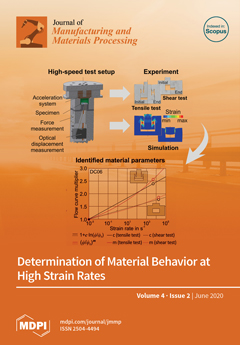Open AccessFeature PaperArticle
Influence of Tailored Surfaces and Superimposed-Oscillation on Sheet-Bulk Metal Forming Operations
by
Bernd-Arno Behrens, Wolfgang Tillmann, Dirk Biermann, Sven Hübner, Dominic Stangier, Dennis Freiburg, Alexander Meijer, Sergej Koch, Daniel Rosenbusch and Philipp Müller
Cited by 8 | Viewed by 2914
Abstract
Producing complex sheet metal components in fewer process steps motivated the development of the innovative forming process called sheet-bulk metal forming (SBMF). In this process, sheet metal forming and bulk-metal forming are combined to create a unique forming process in which a component
[...] Read more.
Producing complex sheet metal components in fewer process steps motivated the development of the innovative forming process called sheet-bulk metal forming (SBMF). In this process, sheet metal forming and bulk-metal forming are combined to create a unique forming process in which a component with external and internal gearing is produced in three production steps. However, the high degrees of deformation that occur using high-strength steels and the number of different process steps result in high process forces, strongly limiting the service life of tools. To reduce the forming force during SBMF processes, tool and process modifications were investigated. Therefore, plane-strain compression tests were conducted to examine the influence of a CrAlN PVD coating and tailored surfaces produced by high-feed milling (HF) of tool-active elements on the material flow of the specimens. In addition to the tool-sided modifications, the influence of an oscillation overlay during the forming process was investigated. Based on the results of the compression tests, the surfaces of the active tool elements of the SBMF process were modified in order to transfer the basic experimental results to the production of a functional component. The friction is thus adapted locally in the SBMF process.
Full article
►▼
Show Figures





